
© Damir Yusupov. (Click image for larger version)
Bolshoi Ballet
Swan Lake
New York, David H. Koch Theater
16 and 17 July 2014
www.bolshoi.ru
www.davidhkochtheater.com
Bolshoi on the Hudson
The city’s ballet aficionados are understandably abuzz over the Bolshoi’s visit to the Lincoln Center Festival this year. The company hasn’t been here in almost a decade; they last came in 2005, when Alexei Ratmansky was in charge. That was the year most of us got our first glimpse of Ratmansky’s work. Those performances of The Bright Stream, starring Maria Alexandrova and Yan Godovsky, were a kind of revelation. Who knew ballets this lively and joyous were still being made? And how the company danced it! A brave new world was upon us.
The situation has changed. Since 2011, the company has been led by a former principal dancer, Sergei Filin, who last year suffered a brutal attack that has left his sight permanently impaired. There are new stars to look out for, including the Leading Soloist Olga Smirnova, only twenty-three, about whom news has been reaching our shores for months. (She will dance Swan Lake on July 18 and 20.) And then there is David Hallberg, a home-grown prince with glorious lines and a soaring jump, who, for the last three years, has split his time between American Ballet Theatre – where he began his career – and the Bolshoi.

© Stephanie Berger. (Click image for larger version)
What the company hasn’t brought this time around is any new choreography. It’s rather a disappointment. Instead, we get three of its most well-worn ballets – Swan Lake, Don Quixote, and Spartacus. It is even more disappointing that the troupe should open its run with a Swan Lake so lackluster that it fails to improve upon the two sub-par Swan Lakes we see here regularly, at ABT and at New York City Ballet. This 2001 production by Yuri Grigorovich, who led the company from the mid-sixties to the mid-nineties, does not even manage to tell the story that Tchaikovsky so clearly lays out in the music.
It’s not the dancers’ fault. At every level, the Bolshoi dancers move with thrilling force and fullness. They’re both unmannered and beautifully coordinated, exhibiting a simplicity and harmoniousness that makes this most unnatural art look like something they were born to do. Every dancer in the company seems to have a marvelous jump – and silent landings. And the corps is so synchronized! But Grigorovich’s production doesn’t do them any favors. The stage is cluttered, hung with ugly taupe-and-gold curtains that wall in the space and fail to create any illusion of depth. Who can explain why the first act, supposedly set in or around the palace of Prince Siegfried, appears to take place in an impressionist version of a gothic cathedral, with a kind of altar set up at the rear of the stage? Many of the costumes are cartoonish; Siegfried’s tutor wears a long gown and turban that bring to mind various pseudo-medieval characters in Monty Python sketches. Grigorovich’s choreography for the ensemble is often insipid, repetitive, forgettable. I lost count of how many times a dancer was forced to cross the stage from left to right, then right to left, only to start all over again.
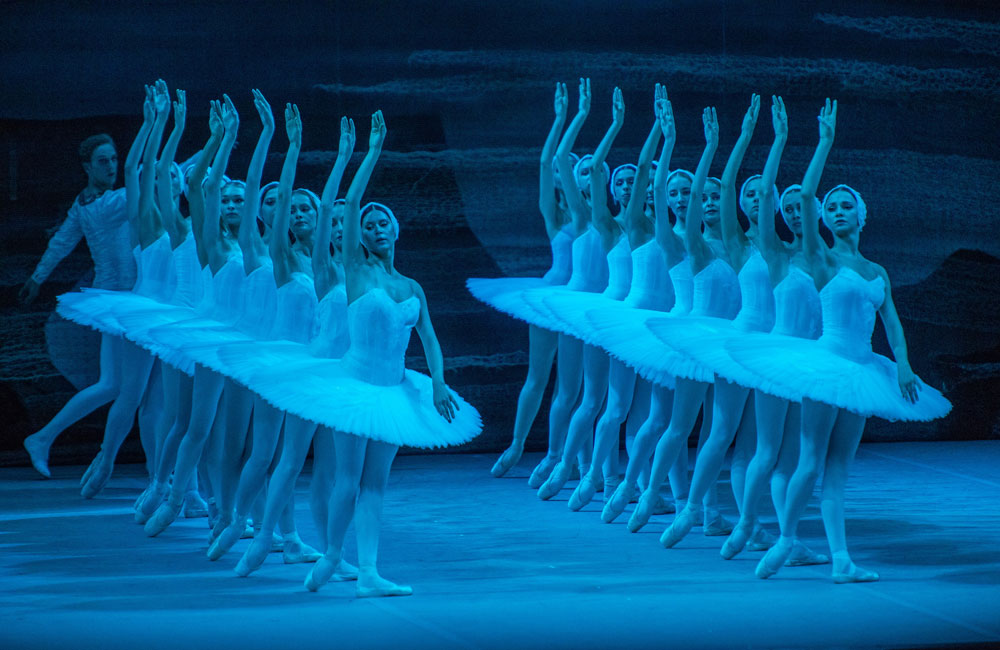
© Stephanie Berger. (Click image for larger version)
Grigorovich has also altered the logic of the story, destroying any sense of causality or character development. (Unhelpfully, he plays around with the order of the music.) In ballets with simple plot-lines like this one, narrative “innovations” almost always complicate matters unnecessarily – Jean Christophe Maillot’s Lac, anyone? Grigorovich’s re-interpretation is not nearly as radical, but it’s irksome and confusing enough. Why does a strange figure in black – an “Evil Genius,” as he’s described in the notes – show up in the first act to torment the prince? How does Siegfried end up in the presence of a flock of swans? Not to mention the ending, in which, for some reason, Odette dies in Mr. Genius’s arms, leaving Siegfried alone to wonder if he dreamed up the whole thing, like Albrecht in Giselle.
Part of the problem is the complete elimination of mime. There’s no presentation of the crossbow, no hunt, no tragic soliloquy for Odette to explain how she ended up trapped in a swan’s body. One’s heart goes out to the dancers, forced to stand there, mutely staring at each other, unable to communicate their plight. We know as little about them as they know about each other.
The two casts July 16 and 17 coped with these limitations with varying degrees of success. On July 16, Anna Nikulina, a leading soloist, was pretty and technically solid but disconnected, her mind too occupied by the choreography to think of anything else. If she ever made contact with her partner, I didn’t catch it. Furthermore, Nikulina’s dancing failed to fill the long tensile lines of Tchaikovsky’s music. Her Siegfried, Artem Ovcharenko (a principal) danced with pleasing lightness and elegance, but gave no inkling of turmoil, either in his acting (non-existent) or his dancing. He was a blank page. Needless to say, their love story never ignited.

© Stephanie Berger. (Click image for larger version)
On the 17th, the cast was led by a starry cast, Svetlana Zakharova and David Hallberg. Zakharova, who trained at the Vaganova Academy in St. Petersburg and started her career at the Mariinsky, is a prime example of everything we think a Russian ballerina should be: impossibly lovely, inconceivably lean, with arms like vines and a supple back that twists and bends in every conceivable way. She’s otherworldly and exquisite, and her Odette is polished to a silvery gleam. Her Odette is like a rare objet-d’art – all curves and supple feet and arching arabesques. It inspires wonder, but little else. But she comes alive as Odile, the seductress sent to lead Siegfried astray. Here, finally, she dances with freedom and a touch of glee. It turns out that, despite her achingly long lines, she is a much more convincing allegro dancer than adagio. Her lengthy bows were as artful as her dancing. (This production provides pauses for bows at every possible juncture, including just after the fouetté turns of the “Black Swan” pas de deux, in the middle of the coda.)
David Hallberg, the hometown hero, burst onto the stage with a diagonal of soaring jetés – he is the owner of perhaps the most glorious jetés in the business. But he had an off night, with several turns going astray toward the end of the evening. He is a dancer in transition, no longer the exciting, long-limbed phenomenon he was just a few years ago, but a thoughtful, searching stage presence in search of a story. The production’s lack of character development presents a particular challenge for such a dancer; one can sense his hunger to connect, but there’s absolutely nothing for him to hold onto.

© Stephanie Berger. (Click image for larger version)
On both nights, the poetic highpoint came near the end. The final ensemble for the swans, built out of simple walking steps, arabesques, and crossing lines, finally gave voice to all the longing that had been missing up to that point. But there were many moments of fine dancing. In the third-act “national” dances, which Grigorovich has unfortunately put on pointe and drained of almost any national color, Anna Tikhomirova stood out for her buoyant beaten jumps in the tarantella and Yulia Grebenshchikova for her proud balances and head shakes in the czardas. Maria Vinogradova danced with charm and élan, both as one of the ladies in the first act pas-de-trois (July 17) and, even more charmingly, as the Russian princess (July 16). Igor Tsvirko managed to make the pesky jester – a Soviet addition to the character list – into an unsettlingly ironic presence. (One could easily imagine him starting a court rebellion.) And Denis Rodkin was an undeniable force as the Evil Genius; he’ll be performing the lead in Spartacus at the end of next week.
What a pleasure to hear the Bolshoi orchestra; it seems to play with twice as much vigor as any of our resident ensembles. Each section creates a splash of color: percussion that could wake up the sleepiest pensioner, creamy cellos, incisive harps, vibrant horns. Lest we forget, ballet music is music too.













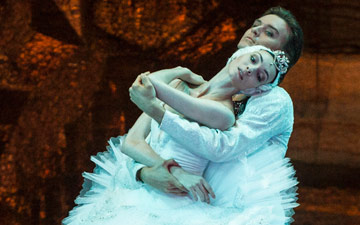
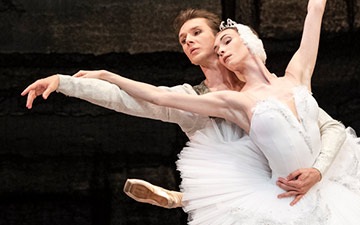
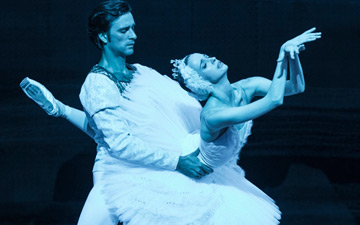
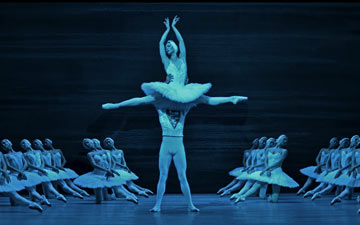
[…] version, currently being performed as part of the Lincoln Center Festival, is no exception. Here’s my review, for DanceTabs. And a short […]
Zakharova Tuesday opening was good.
Smirnova Fri night was A-M-A-Z-I-N-G. She didn’t really knock me out when she guested at ABT a few weeks ago in Le Bayadare. But wow was she great tonight at the theater formerly known as The NY State Theater at Lincoln Center.
I agree the Bolshoi orchestra is just great.